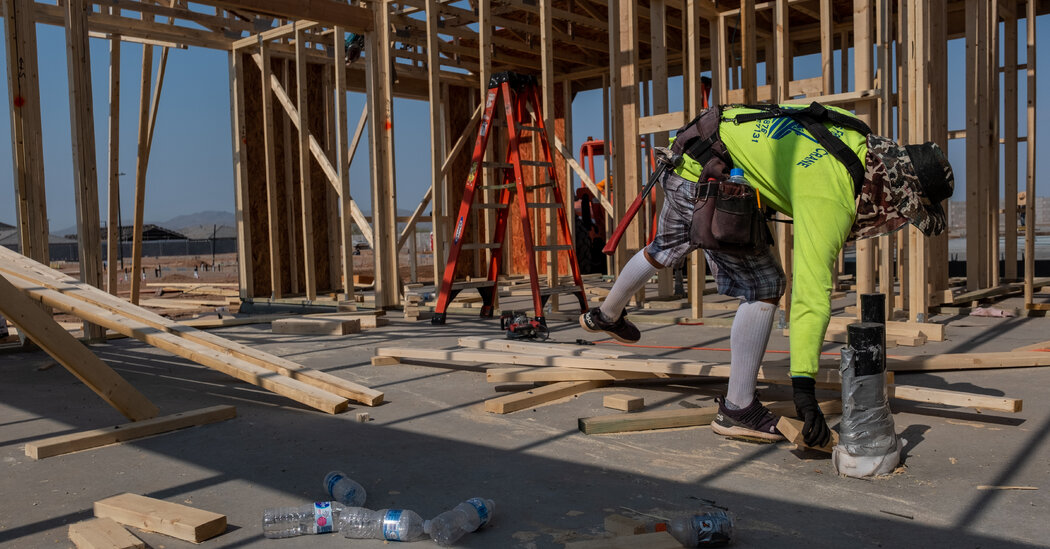
Extreme heat causes many times more workplace injuries than official records capture, and those injuries are concentrated among the poorest workers, new research suggests, the latest evidence of how climate change worsens inequality.
Hotter days don’t just mean more cases of heat stroke, but also injuries from falling, being struck by vehicles or mishandling machinery, the data show, leading to an additional 20,000 workplace injuries each year in California alone. The data suggest that heat increases workplace injuries by making it harder to concentrate.
“Most people still associate climate risk with sea-level rise, hurricanes and wildfires,” said R. Jisung Park, a professor of public policy at the University of California, Los Angeles and the lead author of the study. “Heat is only beginning to creep into the consciousness as something that is immediately damaging.”
The findings follow record-breaking heat waves across the Western United States and British Columbia in recent weeks that have killed an estimated 800 people, made wildfires worse, triggered blackouts and even killed hundreds of millions of marine animals.
But the new data, described in congressional testimony on Thursday, underline how heat waves can also hurt people in unexpected ways.
For example, extreme heat isn’t just a threat to outdoor workers, but also those who work indoors in places like manufacturing plants and warehouses. Those additional injuries mean lost wages and higher medical bills for low-income workers across a huge range of industries, widening the pay gap as temperatures rise.
To understand the link between extreme heat and worker injuries, Dr. Park, along with his co-authors, Nora Pankratz and A. Patrick Behrer, obtained California workers’ compensation injury reports from 2001 through 2018 and built a database of more than 11 million injuries showing the date and ZIP code for each.
The authors combined those reports with the temperature highs for each day and place. They then looked to see whether the number of injuries increased on days with higher temperatures, and by how much.
That strategy offers a new way to estimate the number of heat-related injuries, rather than just relying on the cause of injury listed in workers’ compensation injury reports. Those reports showed an average of about 850 injuries per year that were officially classified as caused by extreme temperature, but the new data suggests that tally is far too low.
On days when the temperature was between 85 degrees and 90 degrees Fahrenheit, the researchers found that the overall risk of workplace injuries, regardless of the official cause, was 5 to 7 percent higher than days when the temperatures were in the 60s. When temperature tops 100 degrees, the overall risk of injuries was 10 to 15 percent greater.
That points to a high number of heat-related injuries that are listed in other categories. The researchers found that extreme heat is likely to have caused about 20,000 extra injuries a year, or 360,000 extra injuries over the 18-year period they studied.
“This is roughly eleven times the number of workplace concussions, and at least nineteen times the annual number of workplace injuries the worker compensation microdata records as caused by extreme temperatures,” the authors wrote.
The findings are set to be made public as a working paper on Monday. Dr. Park previewed his findings on Thursday during a hearing by the House Select Committee on the Climate Crisis.
The additional workplace injury risks that come from high temperatures aren’t spread evenly. The lowest-paid 20 percent of workers suffer five times as many heat-related injuries as the highest-paid 20 percent of workers, the researchers found.
That difference could reflect the type of work that low-paid workers do, compared with their higher-paid counterparts, Dr. Park said. For example, in manufacturing, high temperatures increase injuries by about 10 percent, and 15 percent for workers in wholesale trade jobs. People in those industries are more likely to be exposed to hazardous conditions in the first place, and so difficulty concentrating can translate to getting hurt.
By comparison, workers in finance, insurance or health care saw no strong connection between temperatures and injuries. That could reflect the greater prevalence of air-conditioning in those workplaces, and also the absence of hazards: If somebody who sits at a desk all day struggles to concentrate because of the heat, “there aren’t real safety consequences,” Dr. Park said.
The gap in heat-related injuries between low-paid and high-paid workers could also reflect living conditions.
Researchers at the University of California, San Diego reported this week that low-income neighborhoods around the United States tend to be significantly warmer than wealthier neighborhoods during the summer. The susceptibility of low-income workers to heat-related injuries could stem from a lack of air-conditioning and higher temperatures at home, Dr. Park said.
Income isn’t the only way that heat-related injuries are unevenly distributed among American workers. Hot days are three times as dangerous for men as for women, the data show, perhaps because men are more likely to work in places with hazardous conditions. And for workers in their 20s and 30s, the added risk from higher temperatures is about twice as great as for workers in their 50s and 60s.
The findings also contain a sliver of good news.
The link between extreme heat and workplace injuries weakened after 2005, the researchers found. That’s also the year that California started requiring employers to take steps to protect workers from severe heat, such as providing water, shade and rest breaks for outdoor workers on days hotter than 95 degrees.
While that doesn’t prove that California’s rules led the reduction in heat-related injuries, it raises the possibility that employers and governments can reduce the effect of extreme heat on worker safety, the authors said.
But only so much. After 2005, the link between temperature and injuries didn’t disappear — it fell by about one-third.
One message for lawmakers, Dr. Park said, is that governments should do more to reduce emissions of planet-warming gases such as carbon dioxide, to curb future temperature increases. But in the meantime, workers need more protection from the effects of high temperatures, he said.
“Not only should we be engaging in aggressive climate mitigation — that is, transitioning away from fossil fuels,” Dr. Park told the committee on Thursday. “Policymakers may also want to think proactively about climate adaptation.”

Average Rating